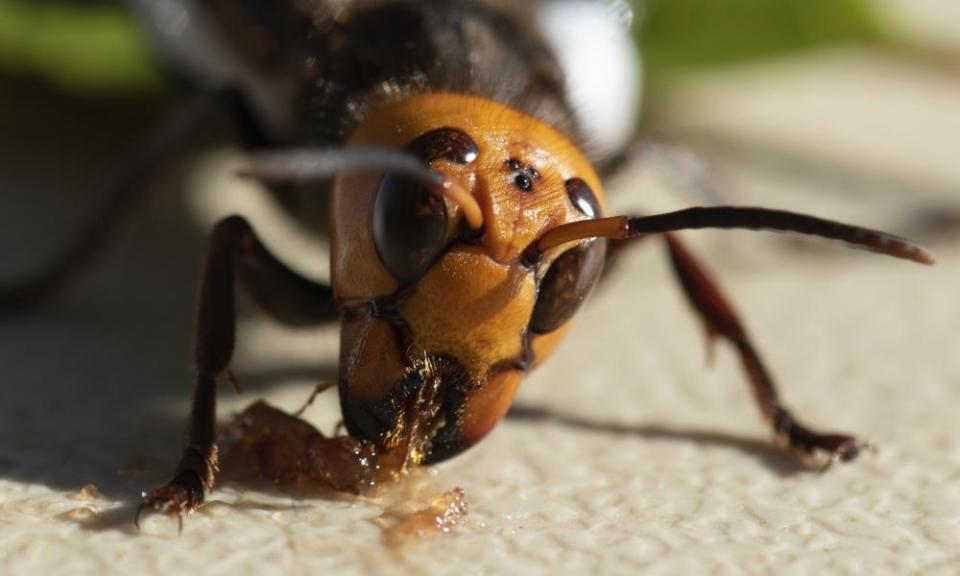Beekeepers brace for next round with Canada's 'murder hornets'

The year 2020 is not one that beekeepers in Washington state and the Canadian province of British Columbia are likely to forget in a hurry. Since the spring, experts in both states have been gripped by fears of Vespa mandarinia, a hulking insect whose voracious appetite for honeybees and stealthy spread could pose a threat to the region’s vulnerable ecosystem.
I squeezed [the queen] on her thorax ... and this huge stinger came out. And the giant mandibles moved, trying to bite me. It was really quite beautiful
Dr Paul van Westendorp
While the eradication of an Asian giant hornet nest in Washington in October was a success, officials to the north in Canada have dealt with a number of setbacks in their own bid to eradicate the hornets.
This summer, British Columbia’s chief beekeeper Dr Paul van Westendorp and his team deployed bottle traps, streamers and radio transmitters in the hope of killing the invasive insects – or leading researchers to underground nests. But they came away empty-handed.
The trouble is, the Asian giant hornet, despite its size, is incredibly difficult to locate, given its tendency to stick to forested areas. Unless a member of the public spots one by chance, there is little officials can do to find them.

“It’s been quite frustrating,” says van Westendorp. “But because they’re an apex predator, they’re few and far between. And it doesn’t help that their nests are often underground.”
Related: ‘Murder hornets’: race to protect North America's honeybees from giant invader
Still, clues keep trickling in. In November, two hornets were spotted in the region, although their locations suggest they come from different populations. Recently, van Westendorp was in his lab, handling the live specimen of a mated queen, captured after she was spotted by a sharp-eyed member of the public.
“I squeezed [the queen] a little bit on her thorax, which she didn’t like very much. She curved her abdomen and this huge stinger came out. And the giant mandibles moved, trying to bite me,” he says, expressing a deep admiration for his foe. “It was really quite beautiful.”
In a bid to map out the battlefield, van Westendorp plotted all the confirmed sightings of the hornet in British Columbia – one in 2019 and five in 2020 – and found they span an area roughly 350 sq km (135 sq miles) in size. The range of the hornets is 7km from their nests.
“In the end, we have six spots, in quite a large area, with no apparent rhyme or reason or association with one another,” he says. “They’re simply arbitrary spots on a map, making it virtually impossible to really pinpoint where any of these nests could be.”
British Columbia officials know they have lost any chance of locating the nests for now. Winter means that mated queens will have left their nests and gone into hiding. Few will survive, but those that do will have the chance to create their own nests.
This is not just a worry for the state’s beekeepers. The Asian giant hornet is a threat to far more than just honeybees. Vespa mandarina is an opportunistic predator, meaning it also feasts on local insects like grasshoppers and even the yellow jackets hornet, none of which have a defence against its stinger, mandibles and venom.
It's hard to imagine them not having a big impact on the ecosystem if they establish themselves
Alison McAfee
“They’re so high on the food chain that they are preying on other predators,” says entomologist Alison McAfee. “It’s hard to imagine them not having a big impact on the ecosystem if they are truly able to establish themselves.”
One glimmer of hope for entomologists is that the hornets and their colonies lack genetic diversity, a key trait needed for surviving new and often hostile environments.
“A lack of genetic diversity is a big problem for a species that disperses to new regions that they have not previously experienced before,” McAfee says. “It’s not actually 100% clear that they’re here to stay.”

Enough sightings, however, have told researchers the hornets have at least established some form of beachhead, both in British Columbia and Washington. Van Westendorp is already planning his strategy for the coming year, and the one after.
“We’ll be back with more traps in the new year,” he says. “And the year after that too, if needed. It could be a long fight.”
Find more age of extinction coverage here, and follow biodiversity reporters Phoebe Weston and Patrick Greenfield on Twitter for all the latest news and features

 Yahoo Finance
Yahoo Finance 